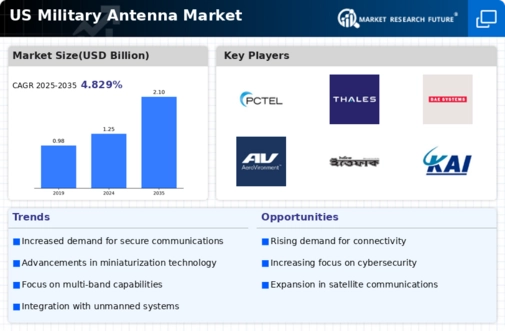The military antenna market is characterized by a dynamic competitive landscape, driven by technological advancements and increasing defense budgets. Key players such as Harris Corporation (US), Northrop Grumman (US), and Raytheon Technologies (US) are at the forefront, focusing on innovation and strategic partnerships to enhance their market positions. Harris Corporation (US) emphasizes the development of advanced communication systems, while Northrop Grumman (US) leverages its expertise in aerospace and defense to integrate cutting-edge antenna technologies. Raytheon Technologies (US) is actively pursuing mergers and acquisitions to expand its capabilities, indicating a trend towards consolidation in the market. Collectively, these strategies contribute to a competitive environment that prioritizes technological superiority and operational efficiency.
In terms of business tactics, companies are increasingly localizing manufacturing and optimizing supply chains to enhance responsiveness to market demands. The military antenna market appears moderately fragmented, with a mix of established players and emerging firms. The collective influence of key players shapes the market structure, as they engage in strategic collaborations and investments to secure their positions. This fragmentation allows for niche players to emerge, potentially disrupting traditional market dynamics.
In October 2025, Northrop Grumman (US) announced a partnership with a leading technology firm to develop next-generation antenna systems for unmanned aerial vehicles (UAVs). This collaboration is strategically significant as it positions Northrop Grumman to capitalize on the growing demand for UAV applications in military operations, thereby enhancing its product offerings and market reach. The integration of advanced technologies into their antenna systems is likely to provide a competitive edge in a rapidly evolving landscape.
In September 2025, Raytheon Technologies (US) unveiled a new line of multi-band antennas designed for enhanced communication capabilities in diverse operational environments. This launch reflects Raytheon's commitment to innovation and addresses the increasing need for versatile communication solutions in military applications. The introduction of these antennas is expected to strengthen Raytheon's market position and attract new clients seeking advanced communication technologies.
In August 2025, L3Harris Technologies (US) completed the acquisition of a smaller firm specializing in satellite communication antennas. This strategic move is indicative of L3Harris's focus on expanding its portfolio and enhancing its capabilities in satellite communications, which are critical for modern military operations. The acquisition is likely to bolster L3Harris's competitive stance by integrating specialized technologies and expertise into its existing product lines.
As of November 2025, current trends in the military antenna market include a strong emphasis on digitalization, sustainability, and the integration of artificial intelligence (AI) into antenna systems. Strategic alliances are increasingly shaping the competitive landscape, as companies collaborate to leverage complementary strengths. Looking ahead, competitive differentiation is expected to evolve, with a shift from price-based competition towards innovation, technological advancements, and supply chain reliability. This transition underscores the importance of agility and responsiveness in meeting the demands of modern military operations.




















Leave a Comment